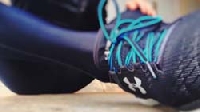
For health or fitness, compression socks can help you
Compression socks and stockings have been around for many years. Doctors and physical therapists have found they provide health and medical benefits. Users have found compression socks and stockings may improve comfort in some cases.
Fortunately, modern technology, weaving techniques and fabric improvements are making compression socks and stockings good looking and easy to put on, which is an improvement over older designs.
Why do people wear compression socks?
Typically, they are worn to improve the health of the legs. Consider wearing compression socks and stockings to:
- Improve blood flow
- Prevent fluid from pooling in the legs
- Help prevent blood clots from forming in deep leg veins
- Aid in relieving symptoms and prevent problems from varicose veins, skin ulcers and deep vein thrombosis
In addition, some people enjoy the way they make their legs feel and say that they have more energy for a longer period of time.
~
How do they work?
Compression socks and stockings work by gently squeezing the lower leg to move blood and other fluids up the leg, improving circulation and reducing swelling. The compression does this by forcing fluids back into the capillaries and preventing other fluid from leaking out of these tiniest of blood vessels. They also prevent larger veins from becoming engorged with blood and potentially flowing backwards, causing congestion. In other words, it?s like a blood traffic jam.
Think of it this way ? the circulatory system is the super highway of the body. The heart pumps oxygenated blood to the extremities and through muscles via the arteries. Along the way, it picks up lactic acid and other waste as it leaves oxygen behind. The deoxygenated and waste-rich blood then makes its way back to the heart through veins. Back at the heart and lungs, the bloodstream picks up fresh oxygen to make more deliveries.
Compression socks have made their way to the athletic world. Studies with runners have shown that a consistent, optimum level of compression makes the artery walls dilate and increase oxygenated blood flow. The veins get compressed, helping to increase the velocity of fluid on the return trip to the heart. For them, this means quicker recovery and decreased soreness.
How to put them on
It?s important that your compression wear is clean, as they will be more flexible and easier to put on. Keep your them close to you bed, so they can be put on first thing in the morning. Morning is best since legs tend to have the least amount of swelling then. Preferably, sit in a chair with a back so you have something to lean against when pulling the garments up. There are a number of ways to get the socks or stocking on. Below is one of the most common and easiest for beginners.
- Turn the sock or stocking inside out holding onto the toe and top at the same time. It might look like a doughnut at this point.
- Put your toes into the toe area then ease the fabric over the foot and slide it past the heel.
- Use your fingers or palms to continue rolling the fabric over the calf and up the leg.
- Try not to grab and pull at the material, as that can make it rip, run or tear.
If you have trouble getting them on, here are some ideas to help:
- Wear rubber gloves. The stickiness of the gloves will help you grip the fabric better.
- If you wear toe-less stockings, try a silk slip sock. Put the slip sock on first, then the compression garment. The silkiness of the sock helps the stocking slide easily into place. Once the stocking is on, the sock can be removed easily.
- Use a stocking butler or other type of mechanical aid. It holds the stocking open as you step into it. There are a variety of devices, so try a few then choose the one that is easiest for you.
There are a wide variety of options when it comes to choosing the right garment for you. There are full foot socks that go up to the knee, sleeves that cover from the knee to the ankle, thigh high stockings, chaps style, and full hosiery. Your doctor or physical therapist can help you determine the right kind for you.

